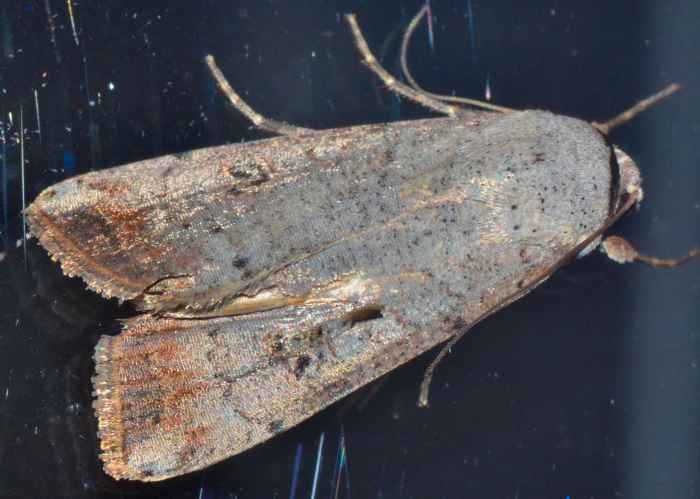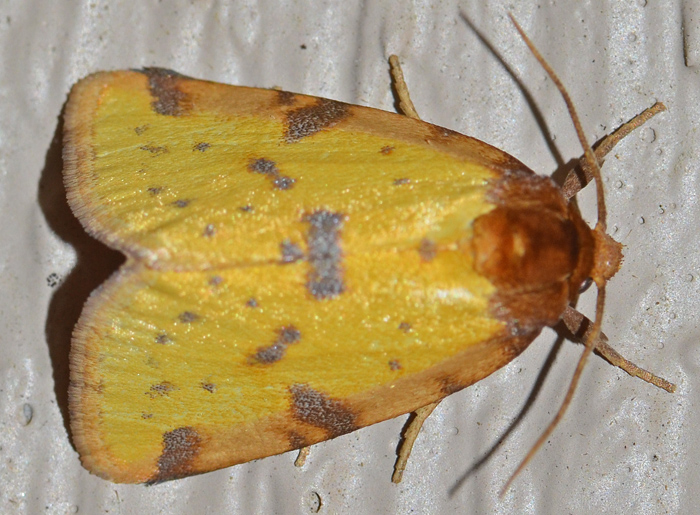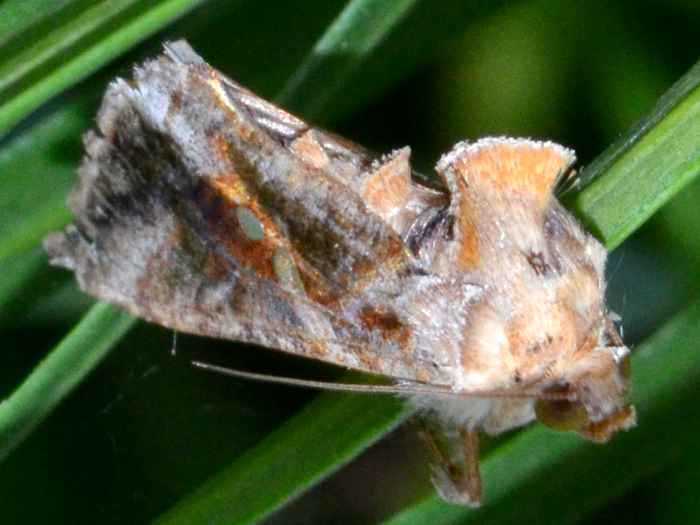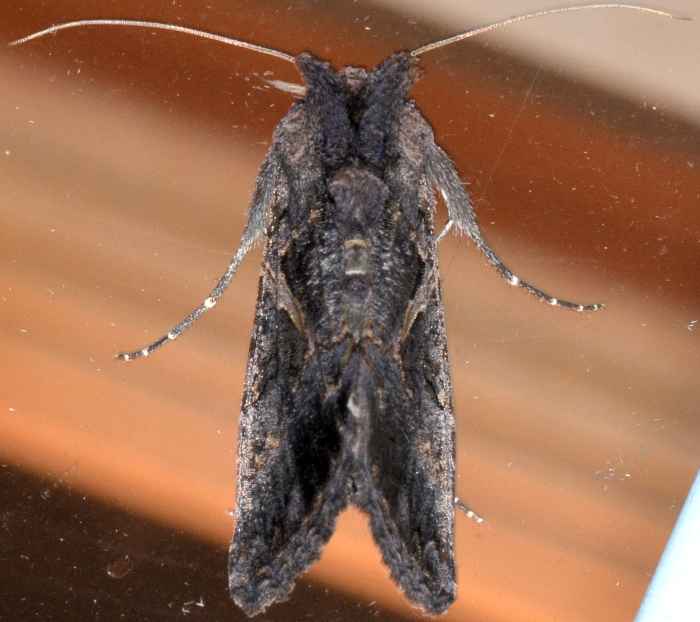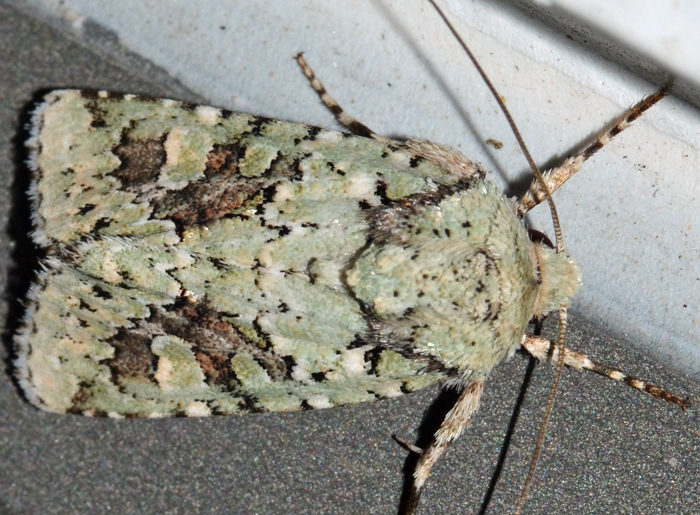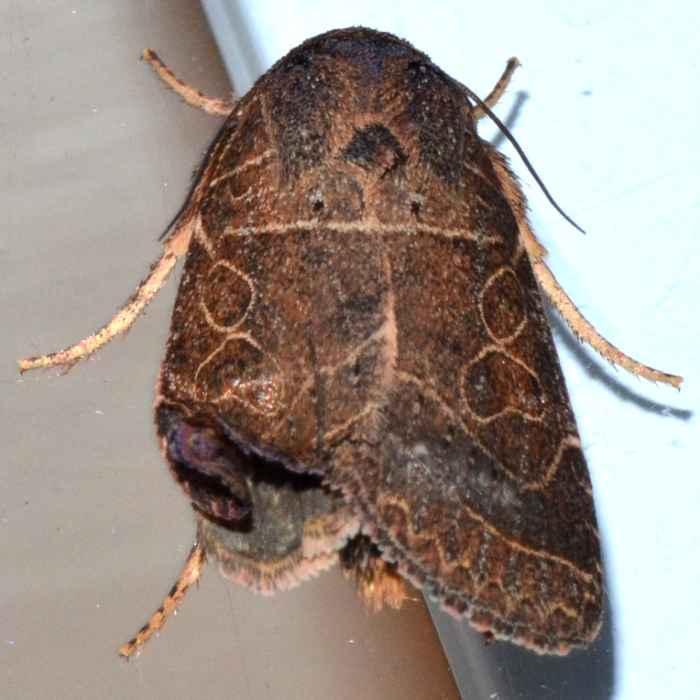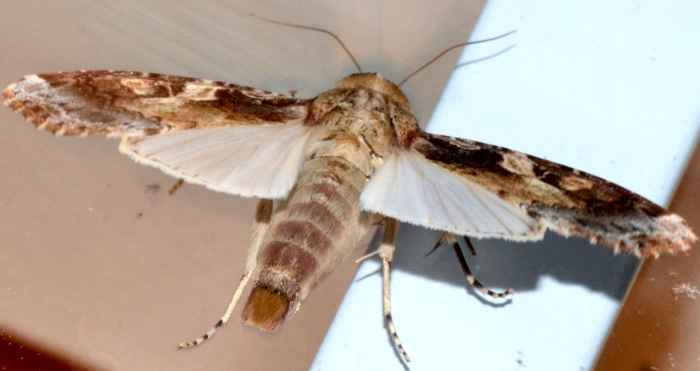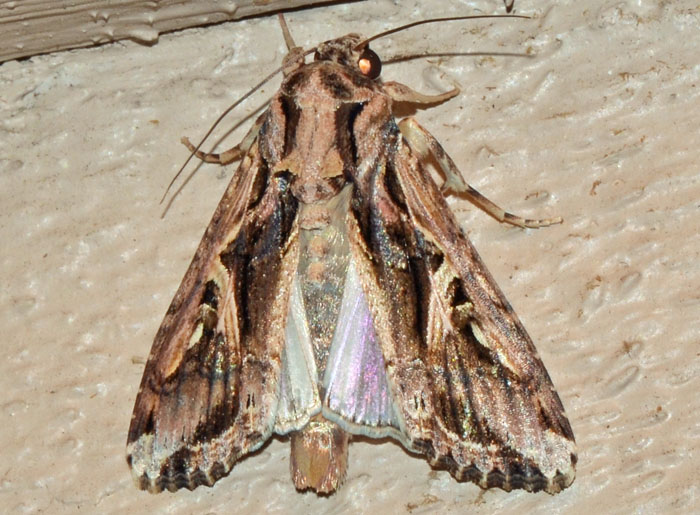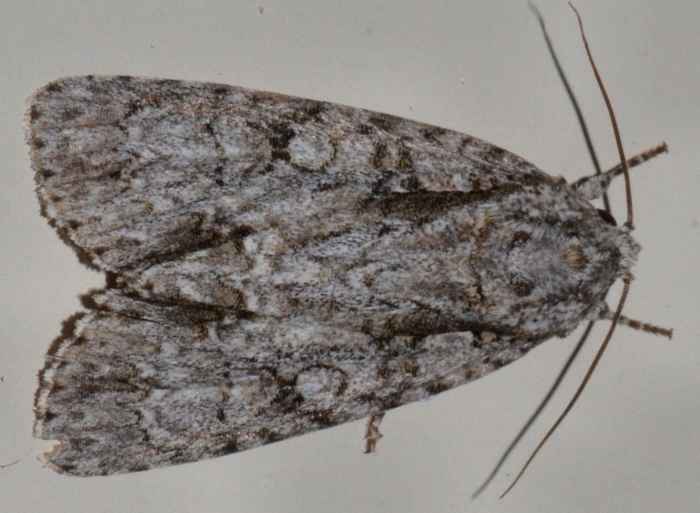 Acronicta sp. (Dagger Moth). | A dagger moth (Acronicta sp.) There are 73 different species of Acronicta in North America. The common name refers to black dagger-shaped markings on the upper forewings, which are not very pronounced on this specimen. Caterpillars of most species have brightly colored, hairy spikes. The caterpillars often feed quite visibly on common foliate trees. bug guide (this photo): http://bugguide.net/node/view/585836 wikipedia: http://en.wikipedia.org/wiki/Acronicta | |
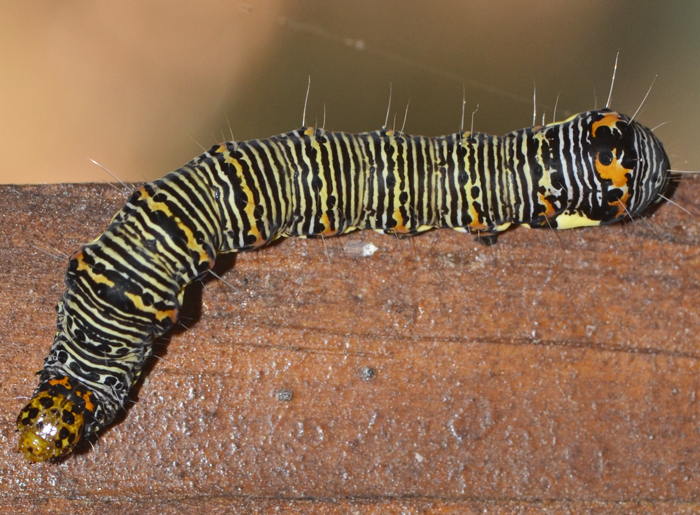 Alypia sp. - imm. | This pretty caterpillar belongs to either Alypia cotomaculata or A. wittfeldii. The latter species is restricted to Georgia and Central and South Florida, while the former is widespread through the eastern half of the US. The adults are black with white or yellowish patches on all wings. The larvae feed on plants including Virginia Creeper (the host varies according to species). bug guide (this photo): http://bugguide.net/node/view/1354391 | |
 Anicla infecta - Hodges#10911 (Green Cutworm Moth). | This common insect is a Green Cutworm Moth (Anicla infecta). It can be found throughout large parts of the Americas. The larvae feed on grasses, beets, and tobacco. The caterpillars are green and unremarkable.
bug guide (this photo): http://bugguide.net/node/view/587192 | |
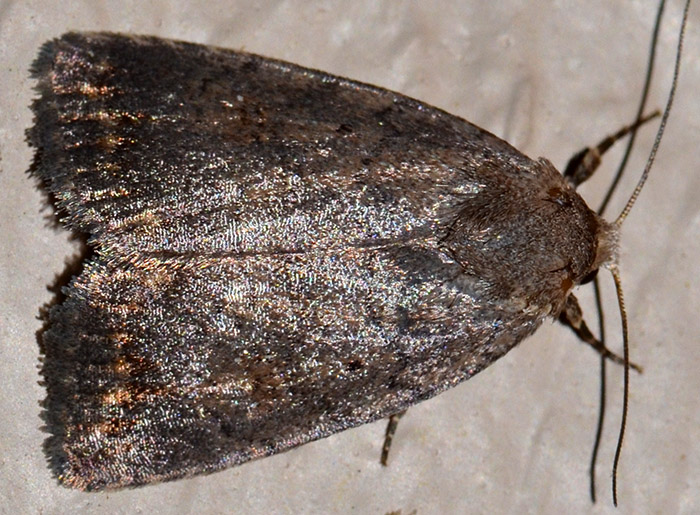 Athetis tarda - Hodges#9650 (The Slowpoke). | According to David Wagner's book on 'Owlet Caterpillars of Eastern North America', this moth is very common in oak woodlands. The book also states that the brownish caterpillars are lethargic and will feign death when disturbed. bug guide (this photo): https://bugguide.net/node/view/1508200 | |
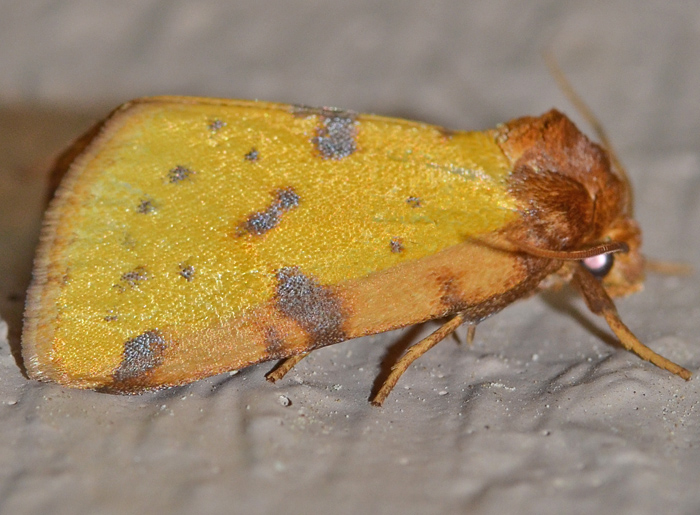 Azenia obtusa - Hodges#9725 (Obtuse Yellow). | Among its grayish brown colleagues, this yellow moth caught my immediate attention. Its larvae have been found on Great Ragweed (Ambrosia trifida), which I (as a mild allergy sufferer) greatly welcome. The wing span of the Obtuse Yellow is about 2 cm.
bug guide (these photos): http://bugguide.net/node/view/1225351 | |
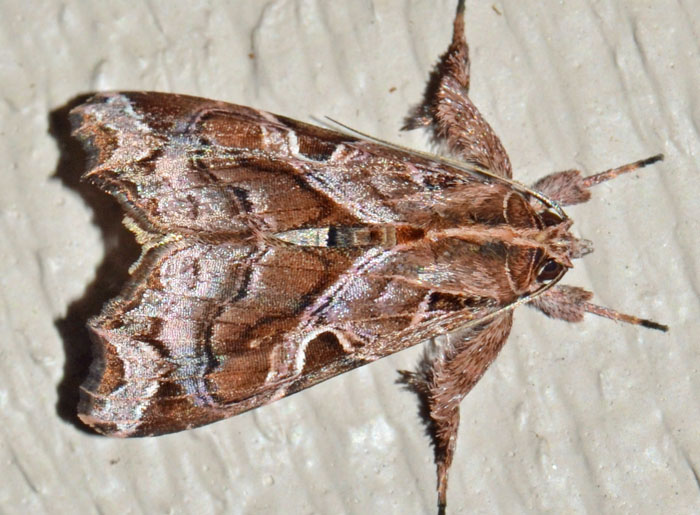 Callopistria floridensis - Hodges#9630 | In North America, the Florida Fern Moth is one out of six species in the genus Callopistria. Its range is not limited to Florida but extends across the entire eastern half of the country. bug guide (this photo): http://bugguide.net/node/view/998119 | |
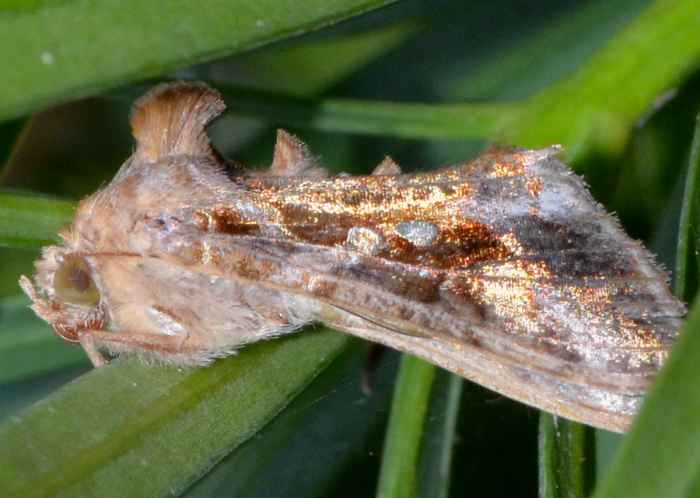 Chrysodeixis includens- Hodges#8890 | I am not sure about this identification but I believe it's a Soybean Looper Moth (Chrysodeixis includens). The genus (formerly Pseudoplusia) has seemingly only one species in our area. Its caterpillar is green with white stripes and feeds on a wide range of plants. The larvae can become a pest on crops.
bug guide (these photos): http://bugguide.net/node/view/571800 | |
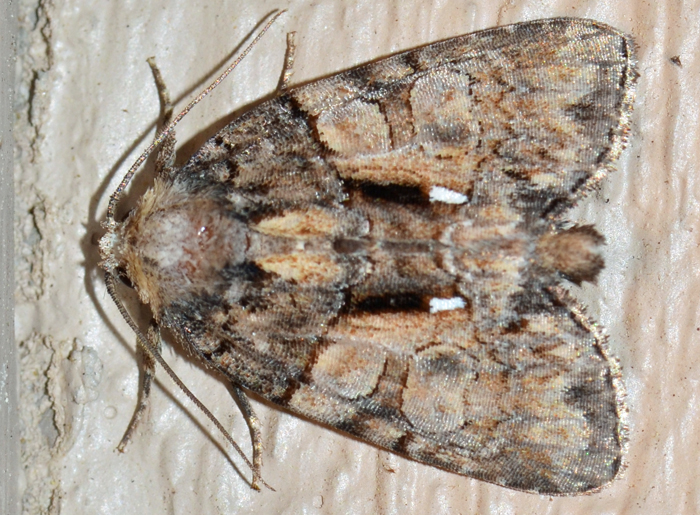 Chytonix palliatricula - Hodges#9556 (Cloaked Marvel). | On one of the last cooler evenings of spring, I noticed this pretty moth near our porch lights. Its wing span is a good inch. The species Chytonix palliatricula has two varieties, one with a large white patch covering most of the forewing, and the other without it. This specimen belongs to the more common latter form. The larvae of the Cloaked Marvel feed on specific mushrooms. bug guide (this photo): http://bugguide.net/node/view/1354461 | |
 Ctenoplusia oxygramma - Hodges#8889 | A Sharp-Stigma Looper Moth (Ctenoplusia oxygramma. The small photo was taken on the same day and might be the specimen.
bug guide (large photo): http://bugguide.net/node/view/634258 bug guide (small photo): http://bugguide.net/node/view/634775 | |
 Elaphria georgei - Hodges#9680 (George's Midget). | This moth is called George's Midget but is really not that small reaching a wingspan of about one inch. Its caterpillars are dark, nearly black, with a long yellow and reddish line. bug guide (this photo): http://bugguide.net/node/view/1348173 | |
 Elaphria fuscimacula - Hodges#9675. | The genus Elaphria has 15 different species in North America and several of them are referred to as "Midgets". bug guide (this photo): http://bugguide.net/node/view/990447 | |
 Elaphria nucicolora - Hodges#9676 (Sugarcane Midget). | The Sugarcane Midget can be found in the southeastern United States and Texas. Its larvae feed on various plants including sugarcane, which explains the moth's English name. The wing span is slightly below one inch.
bug guide (this photo): https://bugguide.net/node/view/164432 | |
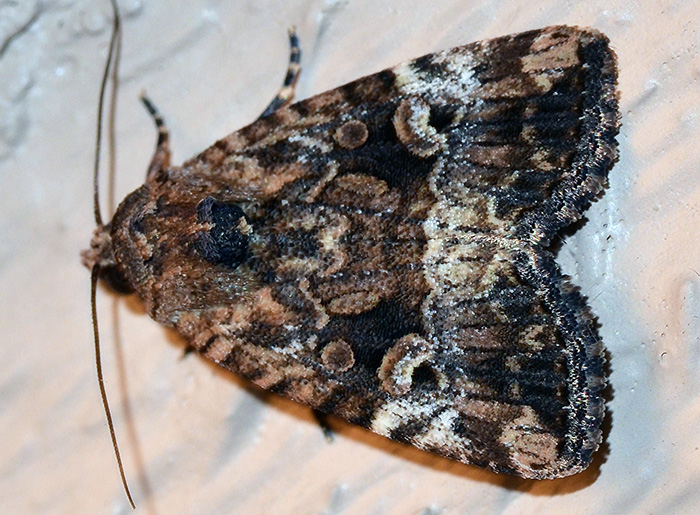 Elaphria exesa - Hodges#9682 (Exesa Midget Moth). | This species is mainly found in Florida. bug guide (this photo): https://bugguide.net/node/view/1816075 | |
 Feltia subterranea - Hodges#10664 (Subterranean Dart). | The Subterranean Dart (also known as Granulate Cutworm) is very common in the Southern US. The larvae can cause damage by cutting off small plants near the ground. They feed on a variety of plants including agricultural relevant vegetable plants. Adults fly year round in the South. bug guide (this photo): http://bugguide.net/node/view/977910 | |
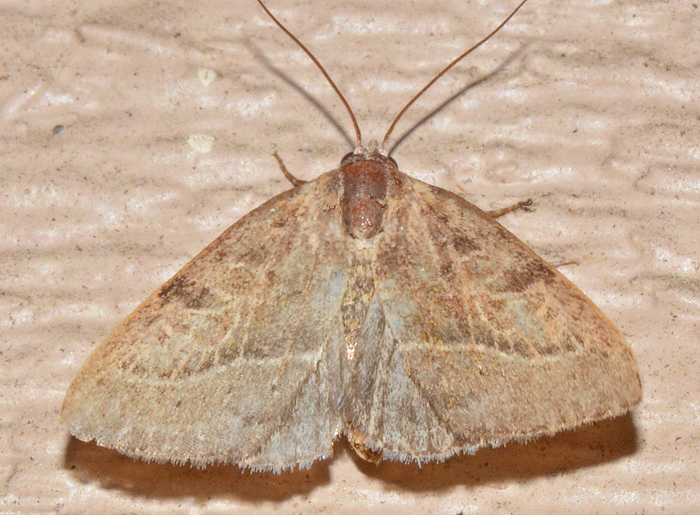 Galgula partita - Hodges#9688 (The Wedgeling). | This rather common moth lives in moist forest habitats throughout much of the US. It is called the Wedgeling. My specimen looks a bit beaten up and worn but I believe it's a male. Males are yellow-brown to orange-brown while females are dark maroon. The faint forewing markings are more evident in the lighter colored males. The larvae feed on wood sorrel (Oxalis sp.). The small photo (taken on 4/9/16 at 10 pm) shows a different specimen.
bug guide (this photo): http://bugguide.net/node/view/1205448 | |
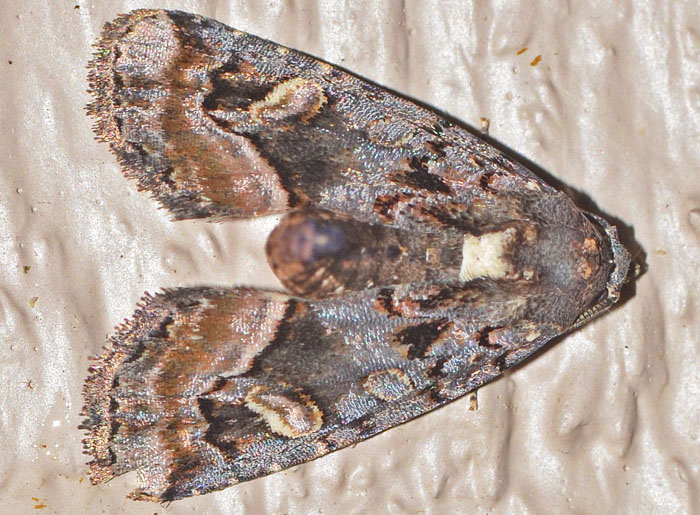 Homophoberia apicosa - Hodges#9057 (Black Wedge-Spot). | The fuzzy spot in the middle of photo is the erect body of this moth. For North America, H. apicosa is one out of two species in this genus. Its larvae feed on smartweed (Polygonum) which (as suggested in the linked text) is an edible weed with a peppery flavor. bug guide (this photo): http://bugguide.net/node/view/990479 | |
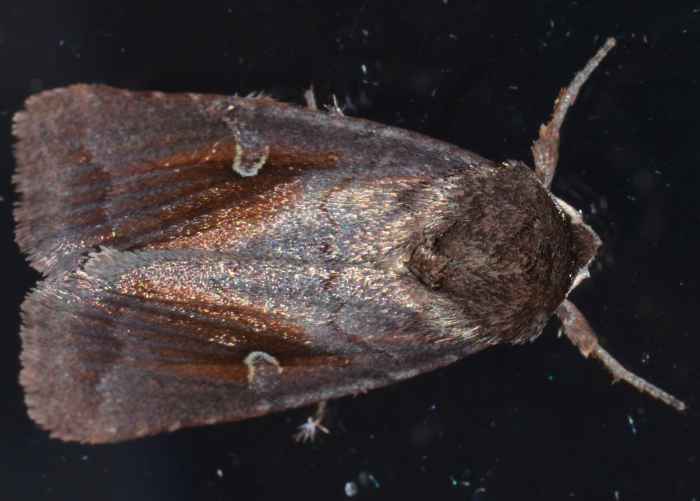 Iodopepla u-album - Hodges#9522 | This moth is a White-Eyed Borer Moth (Iodopepla u-album) and the only species in this genus in North America. Adult moths fly from late March to October and throughout the year in Southern Florida. bug guide (this photo): http://bugguide.net/node/view/584621 | |
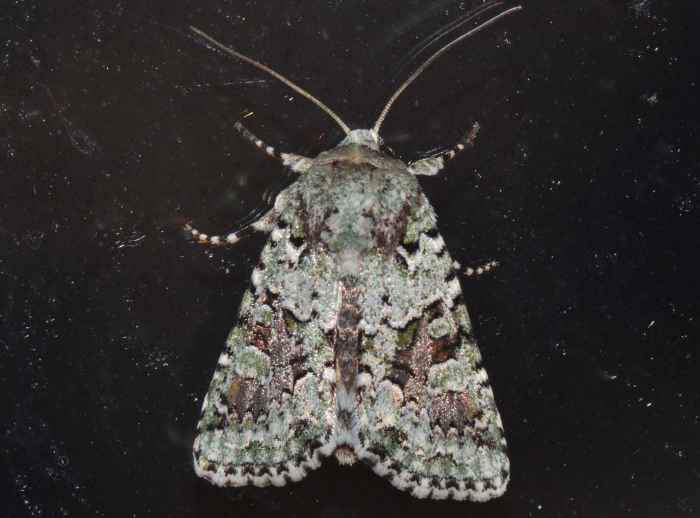 Lacinipolia sp.. | The genus Lacinipolia has over fifty species in North America. Two possible assignments for this specimen are L. laudabilis (Laudable Arches Moth - Hodges#10411) and L. implicata (Implicit Arches Moth - Hodges#10414). The small photo was taken on 04/04/17.
bug guide (this photo): http://bugguide.net/node/view/632730 bug guide (small photo): http://bugguide.net/node/view/1353316 | |
 Leucania sp.. | A wide spread genus with over 30 species in North America. It is possibly L. adjuta, the Adjutant Wainscot. bug guide (this photo): http://bugguide.net/node/view/1074534 | |
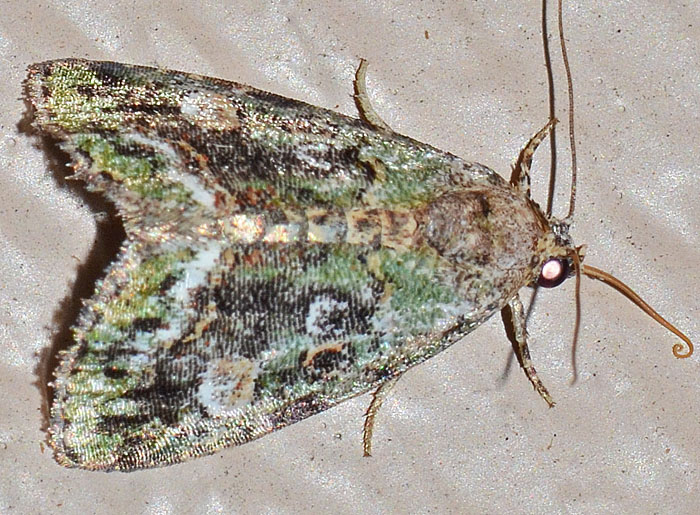 Lithacodia musta - Hodges#9051 | One of three species, the Small Mossy Lithacodia is wide spread in the eastern half of the US. The forewings are dark greenish with blackish shading and lines but the green fades to yellowish in old specimens. Wikipedia refers to this species as Deltote musta. bug guide (this photo): http://bugguide.net/node/view/1080852 | |
 Marimatha nigrofimbria - Hodges#9044 | Found throughout the Eastern US and Texas. This is a Black-Bordered Lemon Moth (Marimatha nigrofimbria). Its bright yellow color, black border, and dark spots are characteristic for this genus. It belongs to the Owlet Moths Noctuidae that are the largest family in Lepidoptera with more than 35,000 species worldwide. For information on this family follow the third link. bug guide (this photo): http://bugguide.net/node/view/560860 moth photographers group: http://mothphotographersgroup.msstate.edu/species.php?hodges=9044 wikipedia: http://en.wikipedia.org/wiki/Noctuidae | |
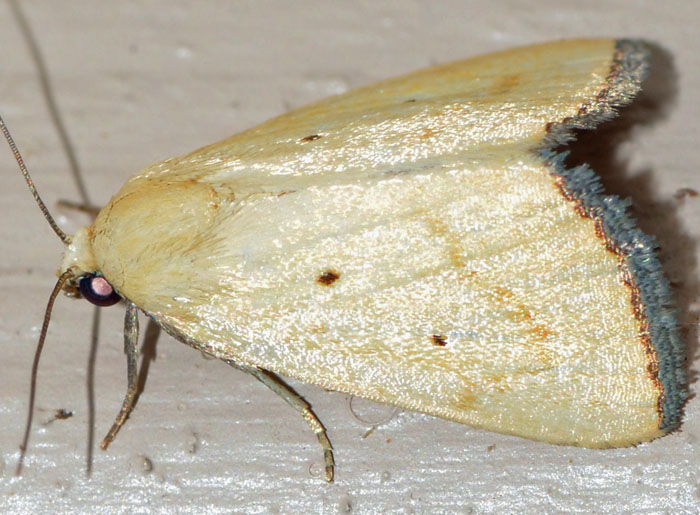 Marimatha tripuncta - Hodges#9045. | This species looks very similar to its sister M. nigrofimbria but in Florida it is the only species with a visible postmedial line. The name giving three spots are not always visible. The range of M. tripuncta is limited to the Caribbean and Florida. bug guide (this photo): http://bugguide.net/node/view/976875 Ferris, LaFontaine, ZooKeys 39: 117-135, 2010: http://zookeys.pensoft.net/articles.php?id=2172 | |
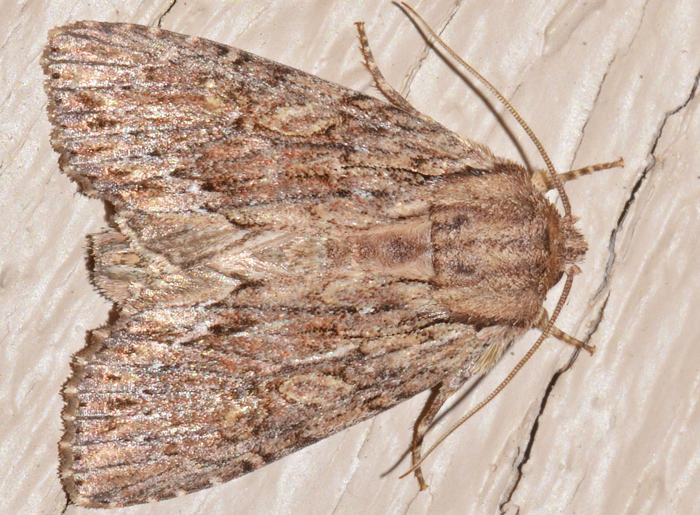 Morrisonia mucens - Hodges#10519 (Gray Woodgrain Moth). | Morrisonia mucens is found primarily from Texas to the Carolinas but can also occur in the Northeast. The wingspan is about 3 cm. Larvae have been reared on Quercus nigra (oak). bug guide (this photo): http://bugguide.net/node/view/1204772 J.B. Smith Contributions Toward a Monograph of the Noctuidae of Temperate North America (Washington, 1889): http://tinyurl.com/Morrisonia | |
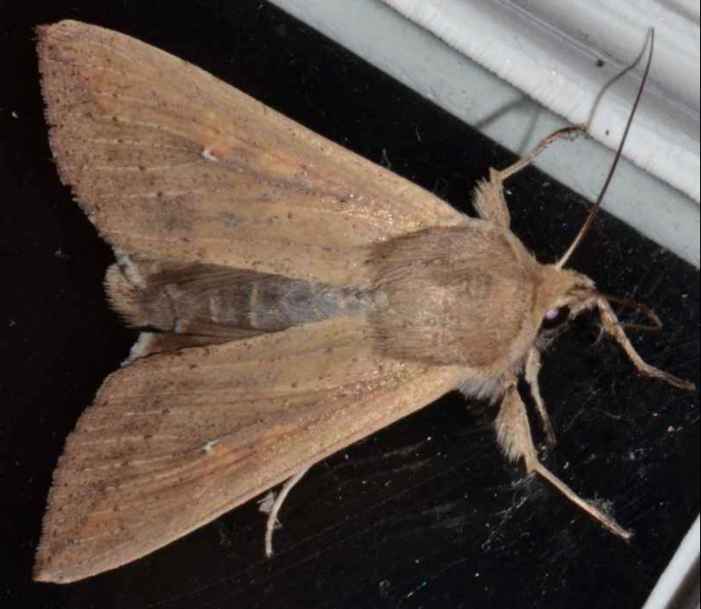 Mythimna unipuncta - Hodges#10438 (Armyworm). | The Armyworm (Mythimna unipuncta) is a very common moth throughout most of North America. Its English name refers to the caterpillars which eat until there is nothing left and then "march" by the thousands to a new food source.
bug guide (these photos): http://bugguide.net/node/view/597352 | |
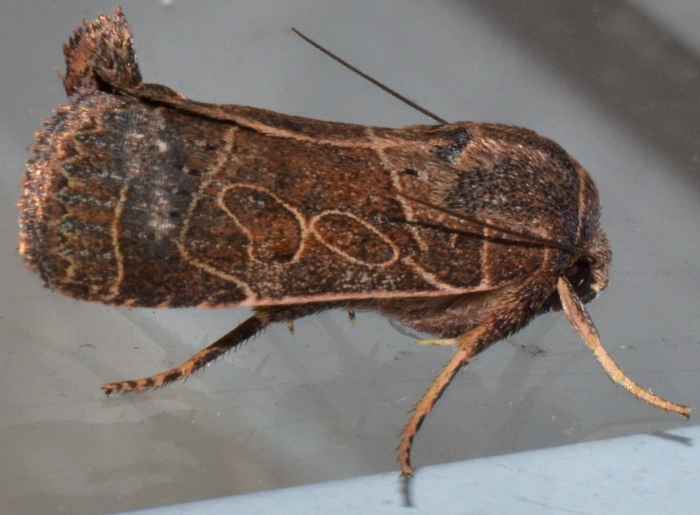 Orthodes majuscula - Hodges #10585 (Rustic Quaker). | Orthodes majuscula or Rustic Quaker is a brownish moth with intricate, yellowish line patterns on its wings. The genus has seven known species in North America. The larvae of the Rustic Quaker feed on a variety of plants such as dandelion and grasses. This specimen was badly injured (see smaller photo below).
bug guide (these photos): http://bugguide.net/node/view/655256 | |
 Ozarba sp.. | This worn moth is perhaps Ozarba nebula which flies year round in Florida. There are four species in the US. bug guide: http://bugguide.net/node/view/143832/bgpage | |
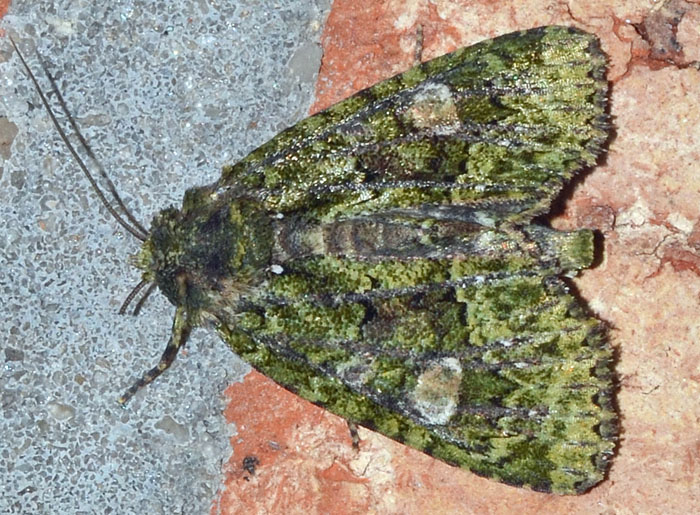 Phosphila miselioides - Hodges#9619 | A pretty green moth with a wingspan of approximately 30 mm. P. miselioides is one out of two North American species in this genus. Its larvae feed on Smilax plants (Greenbrier).
bug guide (this photo): http://bugguide.net/node/view/1085155 | |
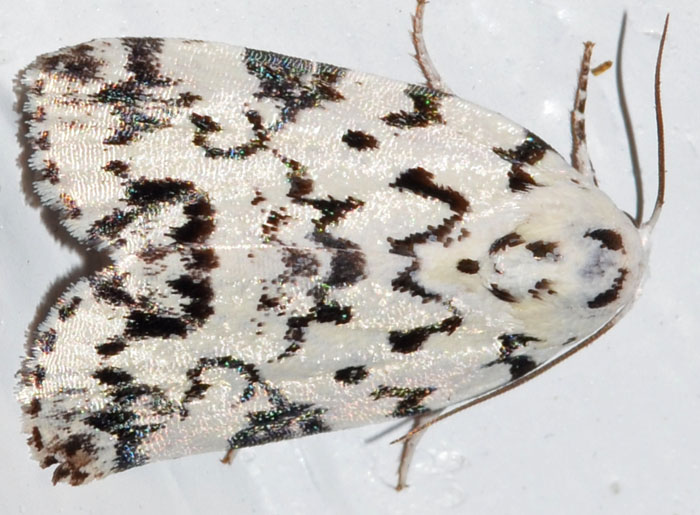 Polygrammate hebraeicum - Hodges#9285 (The Hebrew). | This striking owlet moth is called the Hebrew. The name refers to the black markings on the moth, which must have reminded some people of characters of the Hebrew alphabet. To me it looks more like a 2D bar code. The moth is found in the eastern half of the US and as far west as Texas. bug guide (this photo): http://bugguide.net/node/view/977411 | |
 Protodeltote muscosula - Hodges#9047 | In the US, P. muscosula is a widespread owlet moth with a wingspan of about 2 cm. The larvae feed on swamp grasses, especially saw grass.
bug guide (this photo): https://bugguide.net/node/view/1547187 | |
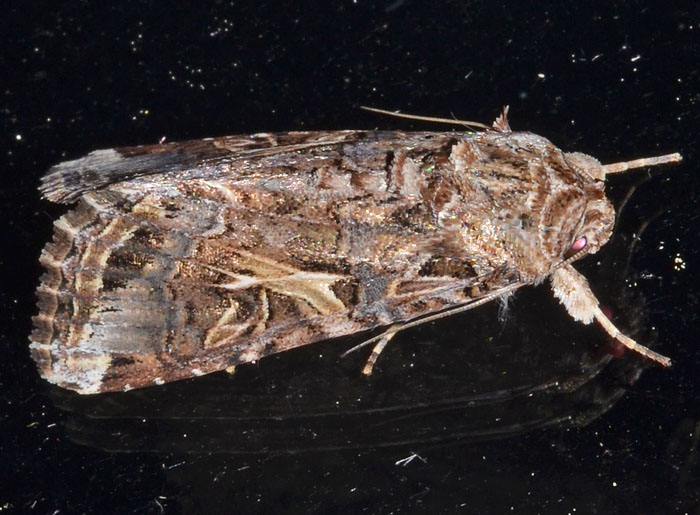 Spodoptera ornithogalli - Hodges#9669 | The wing span of this moth is about 4 cm. Its larvae are called Cotton Cutworm and feed on many herbaceous plants. bug guide (this photo): http://bugguide.net/node/view/1066945 | |
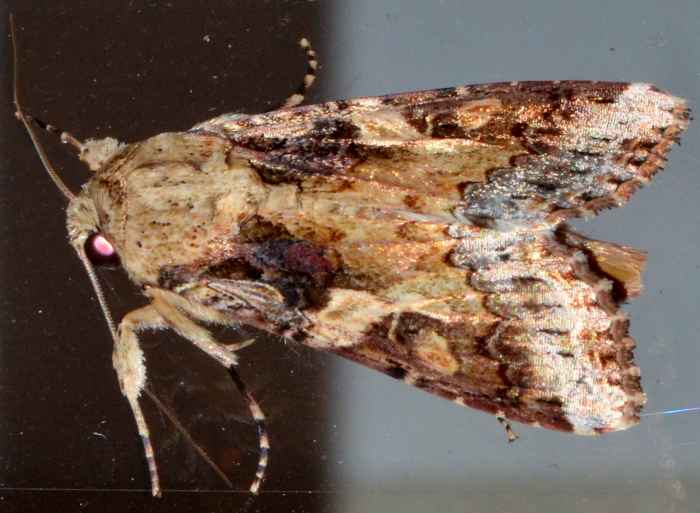 Spodoptera latifascia - Hodges#9670 | The Velvet Armyworm Moth (Spodoptera latifascia) is found in the Southern US and Central America. The larvae feed on the leaves of tomato plants and other crops.
bug guide (these photos): http://bugguide.net/node/view/628914 | |
 Spodoptera dolichos - Hodges#9671 | A Sweetpotato Armyworm Moth--don't you love these names. This species is a Southerner with a range spanning from Texas to South Carolina. In the small photo (06/15/15, 10 pm), the wings are slightly spread but most of the time the moth has them closed and looks nearly elliptical as shown on the left.
bug guide (this photo): http://bugguide.net/node/view/1231948 | |
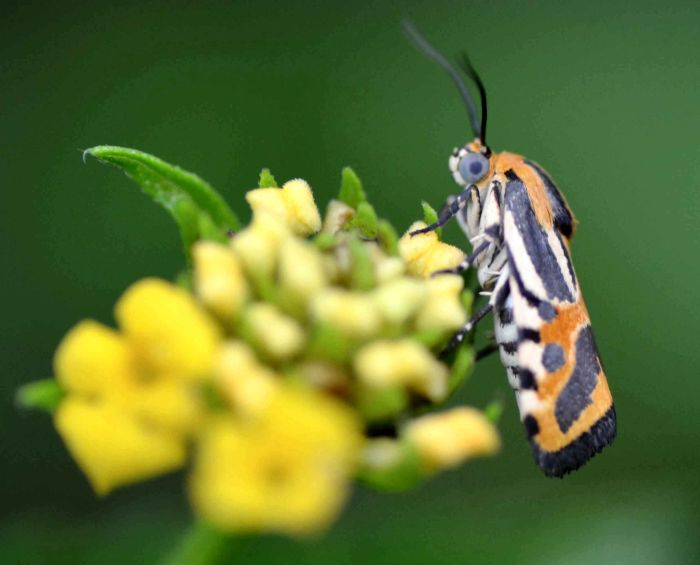 Spragueia onagrus - Hodges#9126 | A very beautiful moth: Spragueia onagrus - Hodges#9126. It's common name is black-dotted Spragueia moth. The bug guide reports this species only for Florida and Georgia but this seems to be misleading. Anyway I couldn't find much information on this small moth. By the way, this is the first (posted) photo taken with my new Nikon D5100. bug guide (this photo): http://bugguide.net/node/view/546820/bgimage | |
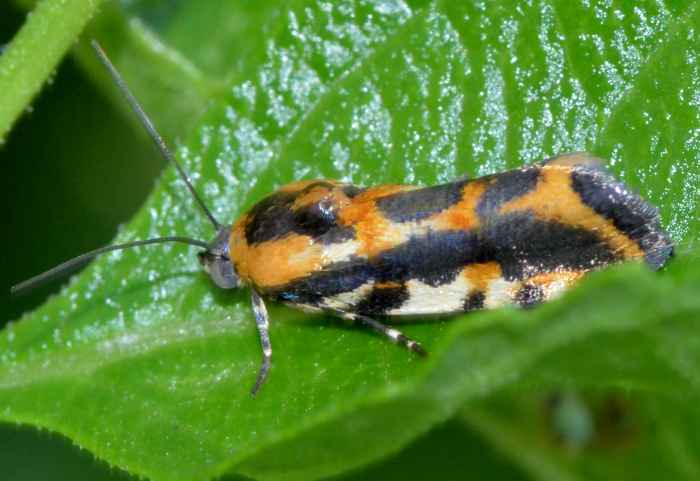 Spragueia leo - Hodges#9127 (Common Spragueia Moth). | These Spragueia moths are surprisingly shiny and always look a bit "photoshopped". This one is the Common Spragueia Moth (Spragueia leo).
bug guide (this photo): http://bugguide.net/node/view/569229#1000058 moth photographers group: http://mothphotographersgroup.msstate.edu/species.php?hodges=9127 Noctuidae of North America: http://www.nearctica.com/moths/noctuid/acontia/spragueia/spragueia_leo.htm |

